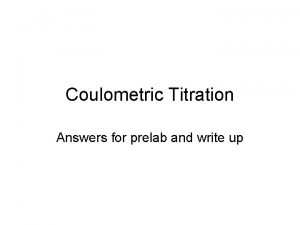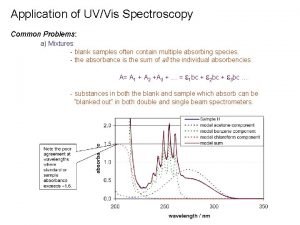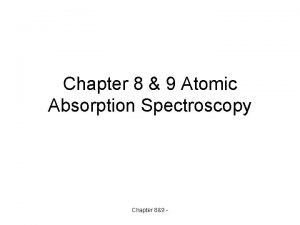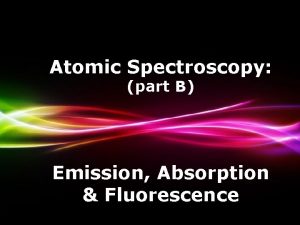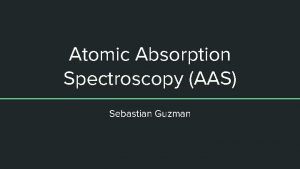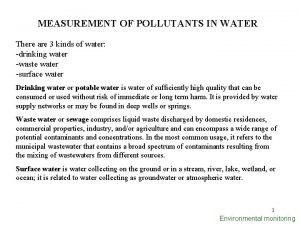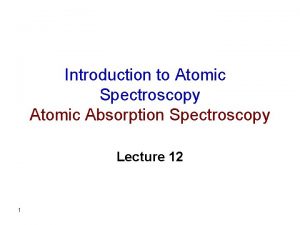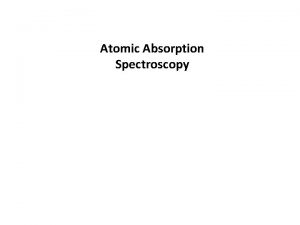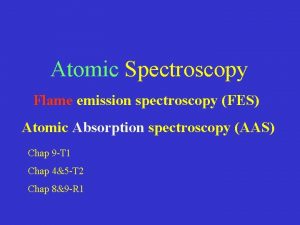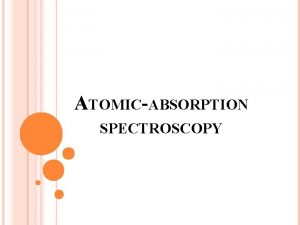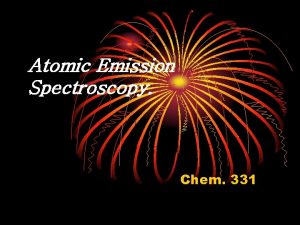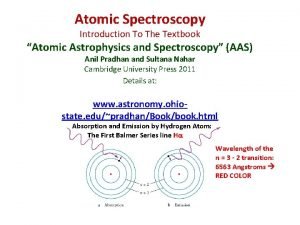INTRODUCTION TO ATOMIC SPECTROSCOPY Shortly after an analyte










- Slides: 10

INTRODUCTION TO ATOMIC SPECTROSCOPY

* Shortly after an analyte atom or molecule is excited, they remain excited state for a time variable in microsecond - nanosecond levels and return to their original state by giving back the energy they have received at the end of this period. * In the application of spectroscopic methods, these two conditions are measured separately. That is, either how much of the intensity of the rays emitted from a given source is measured, which is usually measured as absorbance or transmittance, or the wavelength or intensity of the radiation emitted by the analyte after excitation is measured.

* Accordingly, two different spectroscopic methods emerge in the excitation of atomic analytes by visible and ultraviolet light. * The first method is Atomic Absorption Spectroscopy (AAS), where absorption is measured. * The second method is Atomic Emission Spectroscopy, which consists of two different applications, the first of which is Flame Photometry (AF), the spectral method that emerged in the early 1930 s, and the second is Inductively Coupled Plasma Spectroscopy (ICP), which emerged after the 1980 s). * The major obstacle of atomic spectroscopy is that the sample can be brought into the form to be analyzed. The sample should be placed homogenously and atomized in the light path.

Absorption of Radiation Every molecular species is capable of absorbing its own characteristic frequencies of electromagnetic radiation. This process transfers energy to the molecule and results in a decrease in the intensity of the incident electromagnetic radiation. Absorption of the radiation thus attenuates the beam in accordance with the absorption law. In spectroscopy, attenuate means to decrease the energy per unit area of a beam of radiation. In terms of the photon model, attenuate means to decrease the number of photons per second in the beam.

The Absorption Process The absorption law known as the Beer-Lambert law or just Beer’s law. This law tells us quantitatively how the amount of attenuation depends on the concentration of the absorbing molecules and the path length over which absorption occurs. • As light traverses a medium containing an absorbing analyte, the intensity decreases as the analyte becomes excited. • For an analyte solution of a given concentration, the longer the length of the medium through which the light passes (path length of light), the more absorbers are in the path, and the greater the attenuation. • Similarly, for a given path length of light, the higher the concentration of absorbers, the stronger the attenuation. • The term monochromatic radiation refers to radiation of a single color; that is, a single wavelength or frequency. • In practice, it is virtually impossible to produce a single color of light.

The attenuation of a parallel beam of monochromatic radiation Absorbing solution of concentration c P 0 P b P 0 = Incident beam P = Transmitted beam by the solution b = Path lenght (thickness), cm c = Concentration of solution, moles per liter T = Transmittence A = Absorbance

• Because of interactions between the photons and absorbing particles, the radiant power of the beam decreases from P 0 to P. • The transmittance, T, of the solution is the fraction of incident radiation transmitted by the solution • Transmittance is often expressed as a percentage and called the percent transmittance.

Absorbance • The absorbance, A, of a solution is related to the transmittance in a logarithmic manner. • Notice that as the absorbance of a solution increases the transmittance decreases. • Absorbance can be calculated from percent transmittance as follows:

• To compensate for these effects, the power of the beam transmitted through a cell containing the analyte solution is compared with one that traverses an identical cell containing only the solvent, or a reagent blank. • An experimental absorbance that closely approximates the true absorbance for the solution is thus obtained, that is, • Because of this close approximation, the terms P 0 and P will henceforth refer to the power of a beam that has passed through cells containing the solvent (or blank) and the analyte solution, respectively.

Lambert-Beer Law • According to Beer’s law, absorbance is directly proportional to the concentration of the absorbing species, c, and to the path length, b, of the absorbing medium. A = log (P 0 / P) = a b c • In Equation, a is a proportionality constant called the absorptivity. Because absorbance is a unitless quantity, the absorptivity must have units that cancel the units of b and c. • When we express the concentration in Equation in moles per liter and b in cm, the proportionality constant is called the molar absorptivity and is given the symbol ε. Thus, A = ε b c
